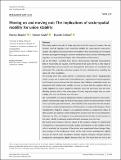Files in this item
Moving on and moving out : the implications of socio-spatial mobility for union stability
Item metadata
| dc.contributor.author | Shapira, Marina | |
| dc.contributor.author | Gayle, Vernon | |
| dc.contributor.author | Graham, Elspeth | |
| dc.date.accessioned | 2018-08-08T10:30:07Z | |
| dc.date.available | 2018-08-08T10:30:07Z | |
| dc.date.issued | 2019-03 | |
| dc.identifier | 255221137 | |
| dc.identifier | 2cf3da52-9c30-46f8-b48c-66bacfe4b5b1 | |
| dc.identifier | 85052461804 | |
| dc.identifier | 000461078200016 | |
| dc.identifier.citation | Shapira , M , Gayle , V & Graham , E 2019 , ' Moving on and moving out : the implications of socio-spatial mobility for union stability ' , Population, Space and Place , vol. 25 , no. 2 , e2180 . https://doi.org/10.1002/psp.2180 | en |
| dc.identifier.issn | 1544-8444 | |
| dc.identifier.other | RIS: urn:B8071F1A3BE2AF175407B336E3091794 | |
| dc.identifier.uri | https://hdl.handle.net/10023/15781 | |
| dc.description | This research was carried out within the ESRC Centre for Population Change, funded by the Economic and Social Research Council, UK (Grants RES‐625‐28‐0001 and ES/K007394/1). The full reference for the data used in this study: University of Essex. Institute for Social and Economic Research, British Household Panel Survey: Waves 1‐18, 1991‐2008 [computer file]. 7th Edition. Colchester, Essex: UK Data Archive [distributor], July 2010. SN: 5151, http://dx.doi.org/10.5255/UKDA‐SN‐5151‐1 | en |
| dc.description.abstract | This study explores the role of family migration in the life course of couples. We ask whether internal migration and residential mobility for contemporary dual-earner couples has negative consequences for the stability of their partnership and investigate whether any negative changes in partners' employment characteristics following family migration are associated with higher risks of dissolution of their unions. We use the British Household Panel Survey, which provides nationally representative data on households and couples, over the period of 18 years and has a wide range of potentially important prospective and retrospective information on households and individuals. We undertake a duration analysis of union dissolution by modelling the hazard of union dissolution. The findings show that union stability is affected by spatial moves—geographically mobile couples are at higher risk of union dissolution. Long-distance internal migration and frequent moves increase the risk, whereas short-distance residential moves are associated with greater union stability. Overall, we found that the negative effect of family migration on union stability is relatively small and decreases over the time. Similarly, positive effects that some types of family migration might have on union stability also tend to decrease over the time. We found that the risk of union dissolution is better explained by partners' socio-demographic characteristics (age and level of education), and by the characteristics of their union such as its type and duration. Union stability is also associated with the employment and occupational characteristics of both partners, as well as with changes in these characteristics. Negative changes in occupational position or employment status of either partner, but especially of the male partner, increase the risk of union dissolution. However, the effect of changes in the employment characteristics of each partner on the union stability is relatively small and tend to disappear over the time. We found some evidence that the impact of the negative changes in employment characteristics of geographically mobile couples postmigration on the stability of their union is mediated by the gender of the partner who experienced these changes. Negative changes in the employment status of the male partner postmigration slightly increase the risk of union dissolution, whereas negative changes in female partner's employment postmigration slightly decrease that risk. We found that the risk to the union's stability is highest immediately after the adverse changes in the male partner employment status happen, but that the risk reduces with the passage of time. | |
| dc.format.extent | 20 | |
| dc.format.extent | 1605492 | |
| dc.language.iso | eng | |
| dc.relation.ispartof | Population, Space and Place | en |
| dc.subject | BHPS | en |
| dc.subject | Family life | en |
| dc.subject | Longitudinal analysis | en |
| dc.subject | Socio-economic mobility | en |
| dc.subject | Spatial mobility | en |
| dc.subject | G Geography (General) | en |
| dc.subject | H Social Sciences (General) | en |
| dc.subject | 3rd-DAS | en |
| dc.subject.lcc | G1 | en |
| dc.subject.lcc | H1 | en |
| dc.title | Moving on and moving out : the implications of socio-spatial mobility for union stability | en |
| dc.type | Journal article | en |
| dc.contributor.sponsor | Economic & Social Research Council | en |
| dc.contributor.institution | University of St Andrews. School of Geography & Sustainable Development | en |
| dc.identifier.doi | 10.1002/psp.2180 | |
| dc.description.status | Peer reviewed | en |
| dc.identifier.grantnumber | ES/K007394/1 | en |
This item appears in the following Collection(s)
Items in the St Andrews Research Repository are protected by copyright, with all rights reserved, unless otherwise indicated.

